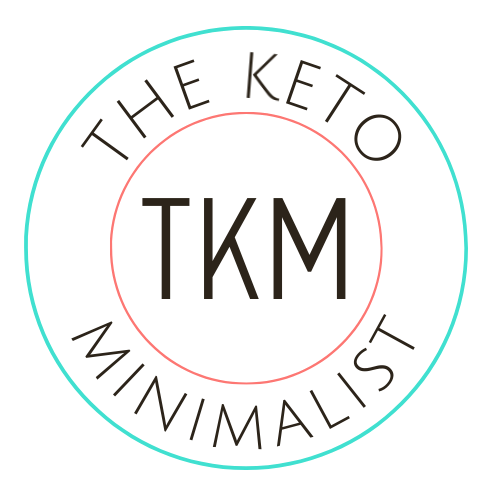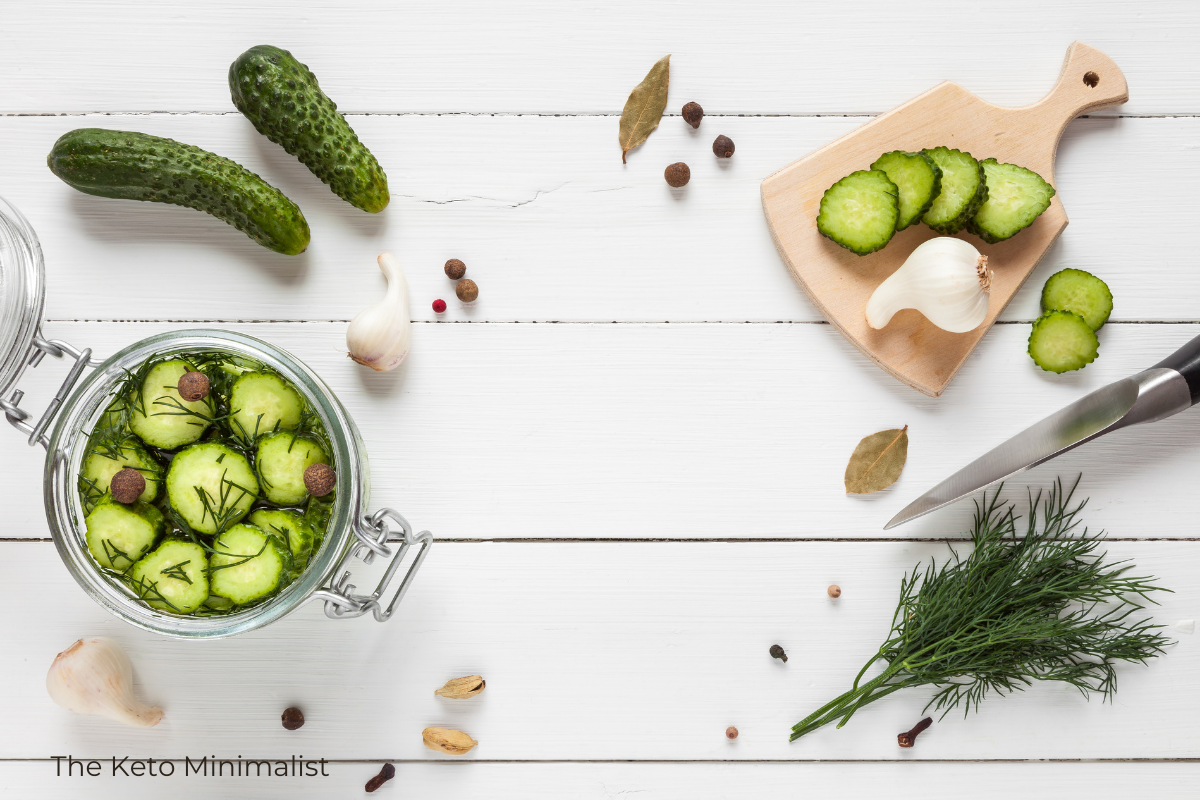8 Keto-Friendly Fermented Foods for Gut Health and Wellness
/Fermentation is the process of breaking down the sugars in foods with enzymes like (good) bacteria or yeast. Not just a boring chemical reaction, fermentation gives foods like sourdough bread, yogurt, or sauerkraut their unique, tangy, or deliciously sour taste. Fermented foods not only taste good, but they have lots of health benefits.
If you follow a ketogenic diet you might wonder what are the best fermented foods to include in your diet.
The top 8 keto-friendly fermented foods to include in your diet are:
Sauerkraut
Kimchi
Pickles
Yogurt
Cheese
Kombucha
Tempeh
Miso soup
While you can just screenshot this list and head to the store, read on to learn why fermented foods will improve your gut health and overall wellness, the benefits of these 8 keto-friendly fermented foods, easy ways to incorporate each into your low-carb eating plan, and carb counts and nutrition facts for each of these tasty and healthy fermented foods.
This post may contain affiliate links for your convenience. This means if you make a purchase, I will receive a small commission at no extra cost to you. For more information, see my disclosures here.
What exactly are fermented foods?
Fermentation is a natural way of preserving foods that has been used for thousands of years.
Cabbage can last a few weeks, but fermented cabbage in the form of kimchi or sauerkraut can last months. Same with dairy products. Milk is fresh for only a few days, while a wheel of fermented cheese like Parmesan or Romano can last years.
Fermentation is the process our ancestors used to keep foods from spoiling.
Fermentation gives foods a unique flavor, aroma, texture, and appearance.
Grape juice tastes very different from a deliciously fermented rich glass of merlot.
Flour and yeast mixed in a bowl have almost no taste. But when that flour and yeast mixture is allowed to ferment it can become a starter to create a delicious loaf of sourdough bread. Fermentation gives the sourdough bread its signature tangy flavor, chewy texture, and crisp, crackly crust.
Why you should include fermented foods on a keto diet.
You should regularly include fermented foods in your diet because they are delicious (think of a rich, full-bodied merlot, or a wedge of Parmigiano-Reggiano) and because there are numerous health benefits to eating fermented foods.
Fermented foods are good for your health because:
They are rich in probiotics which improves gut health and may eliminate digestive issues such as constipation or diarrhea.
Fermentation may make the food easier to digest.
They can improve heart health, possibly lower blood pressure, and lower cholesterol.
They may help with weight loss.
They may boost the immune system.
Good bacteria in fermented foods can help your body produce vitamins it needs, like B1, B2, B3, B5, B6, B12, and K.
They can help restore good bacteria in your gut after a round of antibiotics.
Many wellness experts recommend you include some fermented foods in your diet every day.
Not every fermented food is keto-friendly.
If you follow a keto diet there are many healthy fermented foods you can enjoy and I'll go into more detail about the top 9 keto-friendly fermented foods in more detail. There are also some fermented foods ketogenic dieters should avoid because they are high in carbs.
Now let's dig a little deeper and look at 8 fermented foods can enjoy on a ketogenic diet.
1 - Sauerkraut is a keto-friendly fermented food.
What is sauerkraut?
Sauerkraut is finely cut fermented cabbage and is one of the best-known national dishes of Germany. It has a pungent odor and tangy, sour taste. It's made by combining cabbage and salt (and sometimes other ingredients like caraway or garlic) and allowed to naturally ferment.
Adding fermented sauerkraut to your diet can help improve your digestion, it has tons of probiotics which are important for gut health, it can promote weight loss since sauerkraut is high in fiber and low in calories, and includes important nutrients like vitamins C and K, iron, manganese, potassium, and folate.
Sauerkraut is one of the easiest foods to ferment and, if you want to dip your toes in the world of fermenting, this is a great recipe from The Pioneer Woman. How to Make Sauerkraut (thepioneerwoman.com)
When shopping for sauerkraut, look for the label to say "raw," "fermented," "live," and/or "probiotic." You'll find fermented sauerkraut in your grocery store's refrigerated section. Raw fermented sauerkraut will not contain either sugar or vinegar.
Be sure to avoid canned or pasteurized sauerkraut. The canning and pasteurizing process kill all the gut-health-boosting probiotics.
Some fermented sauerkraut brands to look for are Cleveland Kraut, Farmhouse Culture, Gold Mine, Trader Joe's, Bubbies, Hampton Brine, and Olive My Pickle.
Is sauerkraut keto-friendly?
Sauerkraut is definitely a keto-friendly food with only 1 gram of net carbs per half-cup serving. Typically sauerkraut is made with just cabbage and salt. If additional ingredients are added the nutrition facts may vary slightly. A 1/2 cup serving of sauerkraut has 18 calories, 4 grams of carbs, 3 grams of fiber, 0 grams of fat, and 1 gram of protein.
Ways include fermented sauerkraut in your keto diet.
Because it is so intensely tangy and flavorful, a little bit of sauerkraut goes a long way, and there are lots of creative ways you can use sauerkraut on a low-carb diet:
Use sauerkraut as a side dish with pork chops or pork roast.
Top avocado toast with a bit of sauerkraut. Be sure to use keto-friendly bread, like Scotty’s brand.
Make a delicious Reuben (corned beef, sauerkraut, Thousand Island dressing, Swiss cheese) without bread. (Or use low-carb bread.)
Make this Hot and Zesty Keto Reuben Dip Recipe — The Keto Minimalist and serve with low-starch raw veggies or pork rinds.
Add a bit of sauerkraut to a cauliflower rice bowl.
Top scrambled eggs with a bit of sauerkraut. (This is the amazing scrambled egg recipe I use I Tried the New York Times Scrambled Eggs Recipe and This is What Happened — The Keto Minimalist)
Add a spoonful to soups or stews.
Mix 3/4 cup of well-drained sauerkraut with a softened block of cream cheese for an easy dip.
Sauerkraut pairs well with hotdogs, sausage, or bratwurst.
Use sauerkraut as a tasty condiment on a cheeseburger.
Add a forkful to a salad.
Top a keto-friendly pizza with a bit of sauerkraut.
I like to eat sauerkraut in a little bowl with chunks of cheddar cheese. It sounds weird but it always cures a salt craving.
2 - Kimchi is a keto-friendly fermented food.
What is kimchi?
Kimchi is a staple food in Korean cuisine, and is made from fermented cabbage and other vegetables like daikon radish, green onions, and garlic. It also has Korean red chili flakes, which makes kimchi a spicy condiment.
It is possible to make your own kimchi (and I made it once using this recipe) but it requires a lot of ingredients and a big time commitment. I find it easier to purchase kimchi either at a grocery store, an Asian market, or from a local Korean restaurant. Look for kimchi in the refrigerated section.
Like all fermented foods, a serving of kimchi is brimming with gut-healing probiotics. It may help boost the immune system, help with weight loss, reduce inflammation, may slow aging and support heart health. Source.
RELATED: You will always find kimchi on the menu at a Korean BBQ restaurant. Learn how to eat a delicious keto-friendly Korean meal... How To Eat Keto At A Korean BBQ: A Keto Guide to Dining Out — The Keto Minimalist
Is kimchi keto-friendly?
Even though some kimchi recipes use a tiny bit of sugar, kimchi is considered a keto-friendly food and has less than 1 gram of net carbs per half cup serving. A 1/2 cup of kimchi has 12 calories, 2 grams of carbs, 1 gram of fiber, 0 grams of fat, and 1 gram of protein.
Ways to include kimchi in a keto diet.
Kimchi is quite spicy so, unless you are used to eating kimchi, you'll want to start slow with a small amount. Think of using kimchi as a condiment, like mustard or hot sauce.
Stir kimchi into Asian-themed cauliflower rice bowls.
Add a spoonful of kimchi on top of a grilled burger or grilled Portobello mushroom.
Use as an ingredient in green salad.
Order as a topping or side dish with a keto-friendly meal or cauliflower rice bowl at a Korean barbecue, or Asian restaurant, such as Bibibop.
Spice up your eggs with a bit of kimchi.
Use kimchi to flavor soups or stews, or even braising liquids or sauces.
Add kimchi to a keto-friendly stirfry.
Use as garnish for a low-carb Bloody Mary.
Make a quick Kimchi Stew. I like this recipe.
3 - Pickles are a keto-friendly fermented food.
Look for fermented pickles in your grocery store's refrigerated case and avoid pickles with added sugar or vinegar as ingredients. Look for words on the label such as "naturally fermented," "probiotics," or "no vinegar."
There is nothing wrong with a typical grocery store pickle like Vlasic or Kroger brand, but they don't contain the gut health benefits that fermented pickles offer.
Some popular fermented pickle brands are Kreugermann Pickles, Oregon Brineworks, Olive My Pickles, and Bubbies.
Are pickles keto-friendly?
Fermented pickles are definitely keto-friendly because the only ingredients are cucumbers, water, salt, spices, and herbs. A one-ounce serving of fermented pickles contains 1 gram of carbohydrates, 0 grams fat, and 0 grams protein. Fermented pickles contain no added sugar or vinegar which are common ingredients in typical pickles.
Ways to include fermented pickles in your keto diet.
Fermented pickles can eaten as a snack or used in any way you might use typical pickles. Here are some ideas to get you thinking:
Eat straight out of the container for a tangy treat!
Add to homemade egg or tuna salad.
Make a crunchy pickle dip for snacking. Try this recipe which uses just pickles, cream cheese, and dried beef.
Top a delicious cheeseburger with sliced pickles. Be sure to choose a low-carb bun or skip it altogether for a keto diet.
Serve as a side with hot dogs, kielbasa, or bratwurst.
Use the pickle brine with all the healthy probiotics instead of vinegar to create a tangy salad dressing.
An easy keto meal or snack are roll-ups using ham, turkey, or other lunch meat, cheese, and veggies.
Use the brine to marinate chicken or pork.
RELATED: There are lots of delicious keto roll-up recipes with eMeals, a keto meal planning service. Learn about my experience here.
4 - Greek Yogurt is a keto-friendly fermented food.
Yogurt is a naturally fermented food and a great way to get immune-boosting probiotics. When you follow a keto diet, be sure to look for full-fat Greek yogurt made with whole milk which has less than half the carbs of regular plain yogurt.
Is Greek yogurt keto-friendly?
Full-fat plain Greek yogurt can be a healthy part of a ketogenic diet. A 1/2 cup serving has only 3.5 grams of carbs, 10 grams of protein, and 5.5 grams of fat.
Not all yogurt is keto-friendly, so do read labels. Look for full-fat plain Greek yogurt and avoid any yogurt with added sugar, fruit, or toppings.
Ways to include fermented Greek yogurt in your keto diet.
Yogurt is delicious on its own or as a substitute for sour cream, so there are endless ways to include Greek yogurt on a keto diet.
Sprinkle a bowl of Greek yogurt with a few berries, nuts, and keto-approved sweetener of your choice for a delicious breakfast or snack.
Substitute yogurt for sour cream in any low-carb dip recipe. (Try this Hot and Zesty Keto Reuben Dip recipe!)
Yogurt has meat-tenderizing properties. Add herbs and spices for a yummy and low-carb marinade. (This Yogurt-Marinated Grilled Chicken recipe from Food & Wine Magazine is yummy.)
Use as a substitute for mayonnaise or mix 50/50 with mayonnaise in recipes such as egg salad, chicken salad, or dips.
Add a scoop of Greek yogurt on top of chili or spicy soups.
Make a batch of tzatziki sauce. It's a traditional Greek sauce, usually served with gyros, and can be used to top meat or chicken, or as a dip for low-carb veggies or pork rinds.
Strain Greek yogurt to make yogurt cheese.
Boost the protein (and flavor) of your low-carb smoothies with a scoop of Greek yogurt.
RELATED: I started eating healthy, gut-healing soups when I did Dr. Kellyann’s 5 Day Cleanse and Reset. I did Dr. Kellyann's Cleanse and Reset - My Review and Results
5 -Fermented cheese is a keto-friendly fermented food.
Admittedly cheese was not the first thing on my list when I thought of probiotic, fermented foods, but it makes sense since fermentation and cheese-making is a way of preserving milk going back thousands of years.
But both soft and aged cheeses can give you the health benefits of naturally fermented foods, but not all cheeses are fermented.
Aged Fermented Cheeses
Look for a cheese that has been aged at least six months, but not pasteurized afterward as the pasteurization process will destroy gut-healthy probiotics. Some examples of aged, fermented cheeses are Gruyère, Parmesan, and Swiss.
Soft Fermented Cheeses
Cottage cheese, mozzarella, and ricotta cheese are examples of soft cheeses that are fermented. For cottage cheese, look for the label to say "live cultures" or "probiotic."
Here are 16 keto-friendly fermented cheeses:
Blue cheese
Caciocavallo
Cheddar (raw, unpasteurized)
Cottage cheese
Edam
Emmental
Feta
Gorgonzola
Gouda
Gruyère
Parmesan
Parmigiano Reggiano
Pecorino Romano
Provolone
Ricotta
Swiss
Is fermented cheese keto-friendly?
Almost all fermented cheeses are keto-friendly since they are high in fat and low in carbs. Exact macros will depend on the particular type of cheese. An ounce of aged cheddar has has 0 grams carbs, 9 grams fat, and 6 grams protein. A half-cup serving of Nancy's Probiotic Whole Milk Cottage Cheese has 3 grams of carbs, 2 grams of fat, and 14 grams protein. At 3 grams of carbs it can still be part of a keto diet but be mindful of portion size.
Ways to include fermented cheese in a keto diet.
Likely including fermented cheese in your diet is very easy since cheese is something almost everyone loves!
Enjoy chunks of cheese on their own as a snack or with raw veggies or nuts.
Grate aged Parmigiano Reggiano over roasted Brussels sprouts, broccoli, green beans, or other vegetables.
In the summer nothing is better than fresh mozzarella with sliced red, ripe tomatoes, fresh basil, drizzled with extra-virgin olive oil and balsamic vinegar.
Stir a bit of keto-approved sweetener into a small bowl of ricotta or cottage cheese, add some fresh berries, and sprinkle with cinnamon for a sweet snack or dessert.
Serve your favorite fermented cheese wedges on a charcuterie board.
Have an abundance of basil in your garden? Make perfectly keto homemade pesto sauce with grated Pecorino Romano and Parmesan cheese. This is the recipe I use.
Top a grilled burger with a fermented cheese like gouda or gorzonzola instead of boring ol' American.
Use shredded mozzarella to top a crustless pizza.
Add your favorite fermented cheese to a salad.
RELATED: Crustless pizza is all the rage in the keto community. Click to see what restaurant chains serve crustless pizza.
6 - Kombucha is a keto-friendly fermented food.
Kombucha is a fermented green or black tea drink that has been enjoyed for thousands of years. Not only does kombucha have gut-healing probiotics, but it also has antioxidants and all of the health benefits of tea. Some brands of kombucha have added flavors and sweeteners, and some do not, so definitely read labels if including kombucha on a low-carb diet.
Is kombucha keto-friendly?
Some brands and varieties of kombucha are keto-friendly and others are not. Be sure to look at both the serving size and the carb count when reading a label. If you are new to drinking kombucha, start with a small amount since some people find
Some kombucha drinks are absolutely keto-friendly.
As an example, Kombucha Town Original Ginger Kombucha Tea has 0 grams of carbs, 0 grams fat, 0 grams protein for a one-cup serving and is perfectly fine to include when following a ketogenic diet.
Some kombucha drinks can be included on a ketogenic diet in moderation.
Synergy Organic Raspberry Chia Kombucha Keto, has 3 grams of carbs, 3 grams protein, and 3 grams of fat per one-cup serving. This can definitely be included on a keto diet, but be mindful of how much you are drinking.
Some kombucha drinks should be avoided on a keto diet.
Other kombucha varieties have added sugar, like KeVita Pineapple Peach Master Brew Kombucha which includes cane sugar. A 15-ounce serving has 16 grams of carbs, 0 grams fat, 0 grams protein, which would not be recommended on a ketogenic diet.
How to include fermented kombucha in a keto diet.
Because most kombucha has some carbs, choose your brand and flavor wisely. Consider having a small glass, or half a bottle, with a snack or on its own as an afternoon pick-me-up.
7 - Tempeh is a keto-friendly fermented food.
Tempeh is a soybean product, often used as a meat substitute. Cooked soybeans are combined with brown rice or millet and fermented. It is chewy, has a nutty and slightly bitter flavor, and can be found next to tofu in the refrigerated section of many grocery stores.
Is fermented tempeh keto-friendly?
Fermented tempeh can be appropriate for a ketogenic diet in moderation. A 3-ounce serving of Lightlife Original Tempeh has 6 grams of net carbs (12 grams of carbs - 6 grams of fiber), 18 grams of protein, and 4 grams of fat.
Ways to include fermented tempeh in a keto diet.
Use tempeh as a substitute for croutons in a salad.
Add tempeh to an Asian-inspired stir-fry with low-carb vegetables and cauliflower rice.
Make a yummy low-carb Bolognese sauce (try this recipe).
Use pan-fried tempeh as a substitute for bacon.
8 - Miso soup is a keto-friendly fermented food.
Miso soup is a traditional Japanese broth-based soup, often served in sushi restaurants. Miso paste, a key component of the soup, is fermented soybeans which provide a distinctly rich, toasty, salty-sweet umami, flavor, lots of vitamins and minerals and, of course, gut-healing probiotics.
Look for miso soup at an Asian market, or in the Asian section of your grocery store. You can even order it on Amazon. This brand is endorsed by Iron Chef Morimoto.
If you've never tried miso soup before and are a fan of Bibibop Asian Grill, you can always get a free bowl of hot miso soup with any purchase. (Bibibop has lots of keto-friendly bowl options and you can read about them here.)
Is fermented miso soup keto-friendly?
A one-cup serving of miso soup typically has about 3 grams of carbohydrates, 1 gram of fat, and 4 grams of protein making it suitable for a ketogenic diet in moderation. If you purchase a miso soup with ingredients such as tofu, mushrooms, or seaweed, be sure to check the label for the carb counts. Avoid any miso soup with noodles.
Ways to include fermented miso soup on a keto diet.
A mug of miso soup is a great between-meals snack.
Enjoy a bowl of miso soup before a low-carb meal, particularly one with Asian flavors like a cauliflower rice stir-fry.
Grab a keto bowl at Bibibop and serve yourself a free bowl of miso soup when you pay at the register.
Make your own miso soup - it's really simple! Try this recipe from AllRecipes.
RELATED: You can add low-carb toppings to miso or any soup to add taste, texture, and more nutrition. See 65 Keto-Friendly Soup Garnishes that are Ridiculously Tasty
I hope you enjoyed learning about the benefits of eating fermented foods and which are the 8 best keto-friendly fermented foods to try!
Wishing you happy and healthy eating!
—The Keto Minimalist
Be sure to PIN this post so you can find it in the future!















